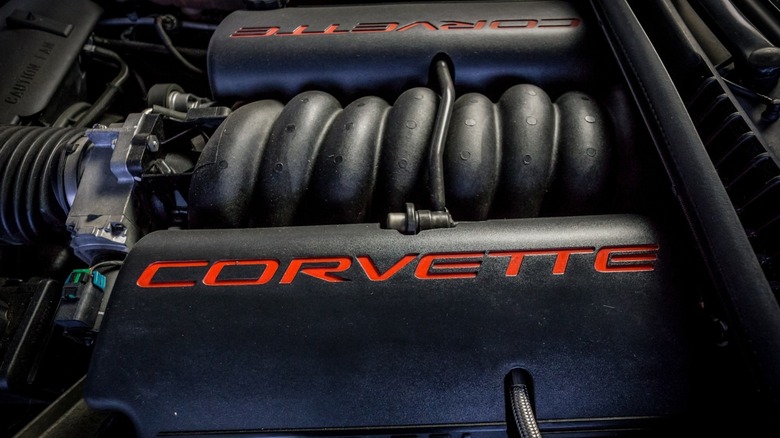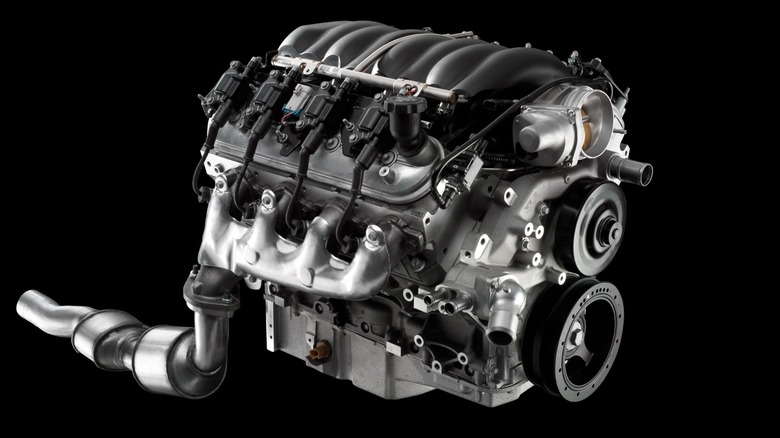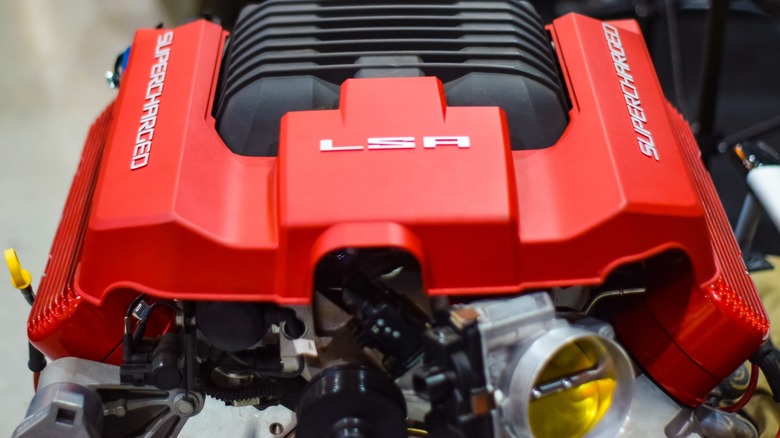4 Of The Most Powerful GM LS Engines, Ranked By Horsepower
General Motors began using LS V8 engines in its muscle car lineup in 1997 with the introduction of the 5.7-liter LS1, the first of its third-generation small block design. That first iteration, used in the 1997 C5 Corvette, produced 345 horsepower and 350 lb-ft of torque. While the LS1 carried over the standard architecture found in the first-gen small block Chevy engine, it featured improvements to the engine block, cylinder heads, manifolds, and pistons compared to the outgoing Gen-II design. However, it retained the 4.40-inch center spacing between cylinders, a centrally located single camshaft, and the pushrod-activated valve train. The LS design allows it to handle more horsepower than previous GM small block versions.
Since every General Motors LS engine is special, asking which LS engine is the best "is like asking a parent which child they love the most," according to Hot Rod Magazine. LS engine swaps are highly popular, and some custom LS builds can produce up to 3,000 horsepower. Therefore, in an effort to avoid the outcry from fans of particular General Motors LS engines, we'll simply point out some of the most powerful models ranked by their advertised horsepower from GM.
The LS3-powered 2008 Corvette had 430 horsepower
The LS3 is special for a number of reasons, including being the first LS to displace 6.2 liters, the first LS to use aluminum cylinder heads with rectangular intake and exhaust ports, and the first LS to significantly surpass 400 horsepower in stock form. Chevrolet debuted the C6 Corvette in 2005 with the LS2 V8 under its hood. At the time, the 6.0-liter LS2 output was rated at 400 horsepower and 400 lb-ft of torque. Chevy introduced the 6.2-liter LS3 V8 into the C6 Corvette lineup in 2008. That iteration of the LS3 had 430 horsepower and 425 lb-ft of torque.
The LS3 powered a number of GM models over its 2008 to 2017 production span, with power ratings between 426 and 436 hp and 420 and 428 lb-ft of torque. In addition to the C6 Corvette, those models include the manual-shift Chevy Camaro SS, the short-lived Chevy SS, the sporty Pontiac G8 GXP, and Australian-based Holden HSV and Commodore VF.
Industrious individuals interested in performing an LS3 swap can either scour the classifieds and junkyards for a donor engine to rebuild or order an LS3 crate engine from GM Performance. While the LS3 crate engine still carries the old-school charm of other GM small blocks, GM Performance hasn't sat idly-by since the LS3 disappeared from production. New LS3 complete crate engines offer horsepower ratings from the original 430 up to the much-improved LS376/515, a 533-hp carbureted LS3 with 477 lb-ft of torque and a suggested retail price of $12,847.25.
The 505-horsepower LS7 debuted in the 2006 Corvette Z06
The LS7 under the hood of the C6 Corvette Z06 produced and advertised 505 horsepower and 470 lb-ft of torque. While GM's LS7 and LS3 are both naturally aspirated, the LS7 features a larger displacement at 7.0 liters. The C5 Corvette Z06 featured the LS6 engine with 405 horsepower, making the C6 Corvette LS7's 100-hp gain quite significant. GM's LS7 powered Chevrolet Corvette models, such as the Z06 and Corvette 427, from 2006 to 2013 and the fifth-generation Chevrolet Camaro Z28 for two model years starting in 2014. Horsepower ratings for the 2014 Z28's LS7 remained the same, but torque output increased to 481 lb-ft.
For a short time in the early 2020s, GM offered a more powerful version of the LS7 as a crate engine, the LS427/570. Since the LS427/570 crate was discontinued, GM no longer has any specs for it online, however, GM Authority and other sources do. The upgraded LS7 delivered a whopping 570 horsepower and 540 lb-ft of torque, making it, at the time, the most powerful naturally aspirated LS crate engine available.
While there are aftermarket LS-based 427 crate engines available that provide serious horsepower, LS7 purists have but one factory crate engine option. GM Performance offers a long-block LS7 service engine replacement designed for the C6 Corvette, priced at $19,883. GM Performance doesn't specify any power ratings, but considering the improvements made to the LS3 crate engine over the years, it's possible it delivers a slight advantage over the 505-hp original.
GM's supercharged LSA V8 made up to 580 horsepower
Unlike the previous two LS engines on this list, the LSA did not make its debut in the Chevrolet Corvette. Instead, it was first offered to the public in the 2009 Cadillac CTS-V, one of the highest horsepower Cadillacs ever made, where it produced 556 horsepower and 551 lb-ft of torque. The most potent version of the LSA, with 580 horsepower and 556 lb-ft of torque, appeared in the 2012 to 2015 Chevrolet Camaro ZL1.
While, on the surface, the GM LSA is just a supercharged version of the popular LS3, there are some differences between the LS3 and LSA. They share the same basic architecture, such as the skirted aluminum engine block, rectangular-port cylinder heads, and the classic small block GM pushrod valve train design. Of course, the 1.9-liter Eaton supercharger sitting atop the LSA is the most notable difference, but GM also adjusted the compression ratio and installed a forged steel crankshaft in the LSA along with nodular iron main caps and piston oil squirters.
Like the LS7, crate engine options for the LSA are limited. The LSA crate engine from Pro Touring, priced at $16,250, advertises near factory specs with an upgraded Eaton solid coupler and ZL1 supercharger cover. However, quantities are limited and contact with the store is required before ordering.
The LS9 is GM's most powerful LS with 638 horsepower
When Chevrolet released the C6 Corvette ZR1 in 2009 it had the most powerful Corvette ZR1 engine of any previous generation. The supercharged 6.2-liter GM LS9 V8 was used from 2009 to 2013 exclusively in the Chevrolet Corvette ZR1, and was available for a short time from GM as a crate engine. Throughout its short five-year production run, the LS9 was rated at 638 horsepower and 604 lb-ft of torque.
Like GM's LSA V8, the LS9 engine was derived from the LS3. They share the aluminum engine block and rectangular port cylinder heads. However, the LS9 uses billet steel main caps and a 2.3-liter Eaton R3200 supercharger to push 10.5 psi of boost pressure through the intake manifold.
Due to the limited production of the LS9, the odds of finding one in a salvage yard are about as good as finding one in a pristine C6 ZR1 in a barn, under a tarp, owned by someone that only drove it on Sundays willing to let it go to someone that will take good care of it. The LS9 was available as a crate engine from Chevrolet Performance for a while after it went out of production. However, according to Bill Martens, Chevrolet Special Programs Manager, the number of available LS9 crate engines was "finite" and "when they're gone, they're gone."



